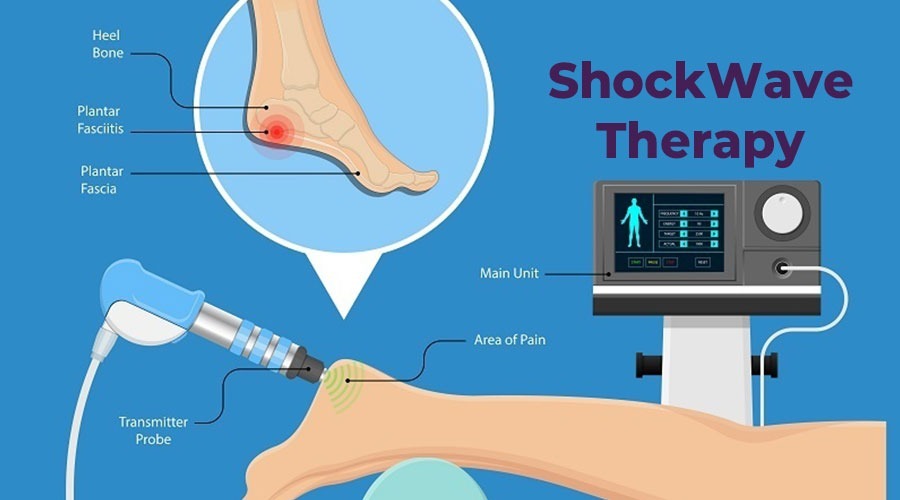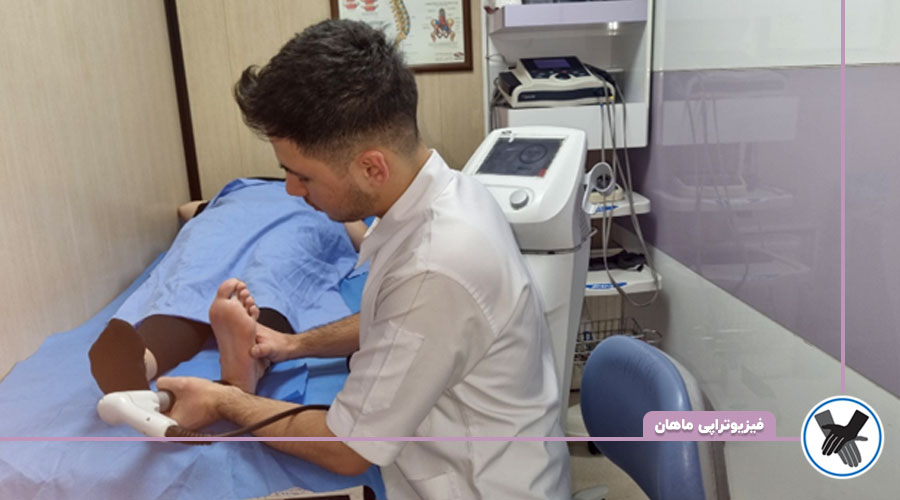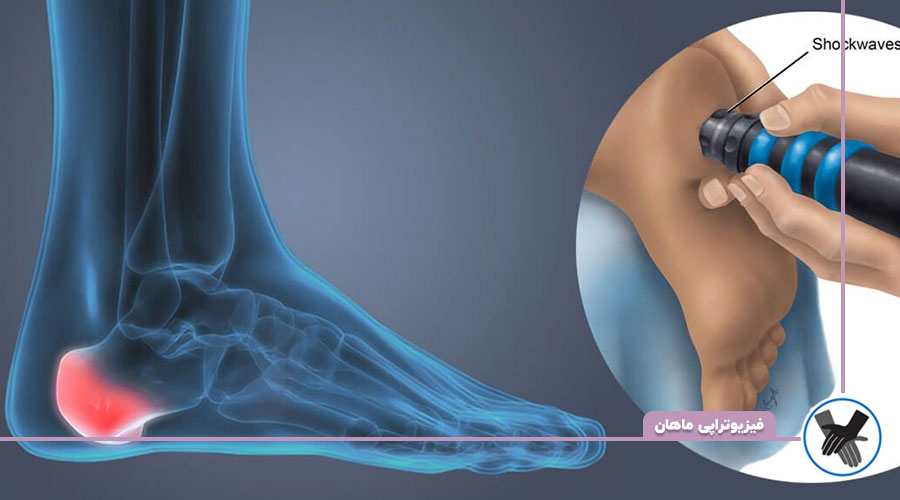Shock wave therapy is a non-invasive option for treating various pains and diseases of the musculoskeletal system. It has been proven that some pathological changes in tendons, ligaments, capsules, muscles and bones can be specifically eliminated with the help of this treatment method. Diseases that are often treated using shock viotherapy include musculoskeletal disease, shoulder inflammation, tennis elbow (tennis elbow), plantar fasciitis, heel spurs.
What is shock wave therapy?
Shockwave therapy is a treatment that uses sound waves to help heal damaged tissue. Sound waves can help improve blood flow and reduce inflammation, and can speed up the healing process. In general, shock wave therapy is used to treat a wide range of injuries. To transfer the waves, some gel is applied to the painful area. Then he uses the shock wave therapy device. The device consists of a handpiece, which contains a fast-moving projectile controlled by a compressor. This projectile transfers energy to the applicator to create radial shock waves that are then propagated through the body and absorbed by the body. The frequency and load of the waves can be adjusted.
- Reduction of pain felt by nerve receptors
- Increase blood circulation in soft tissues
- Stimulation of the healing process caused by the activation of stem cells
- Improving blood flow and neovascularization
- Increase growth factors
- More mesenchymal stem cells
- Stimulation of metabolism
- Reduction of calcification and fibrosis
Uses of shock wave therapy:
This treatment targets your damaged tissue with specially calibrated shock waves that create tiny bubbles in the tissue that then burst, stimulating blood flow, stem cell activity, and pain-relieving enzymes in the treated area. The use of shock waves relieves pain after treatment as well as stimulates normalization and long-term tissue regeneration. Shockwaves reduce pain in part by creating substance P and overstimulating pain sensors. In general, in shock wave therapy, the body regenerates the damaged tissues, resulting in the following effects:
- Reduction of pain felt by nerve receptors
- Increase blood circulation in soft tissues
- Stimulation of the healing process caused by the activation of stem cells
- Improving blood flow and neovascularization
- Increase growth factors
- More mesenchymal stem cells
- Stimulation of metabolism
- Reduction of calcification and fibrosis
Treatment of plantar fasciitis:
Fascia is an inflammation of the fibrous tissue of the sole of the foot, and its primary symptom is pain in the heel and on the top of the sole. This condition may be caused by excessive use of movements such as running and walking or even standing for long periods of time. You may even develop plantar fasciitis after wearing shoes that do not support your arch or protect your feet properly. Shockwave therapy is an effective and non-invasive treatment for this painful and difficult disease.
Patella tendonitis – knee pain treatment:
Patella tendinopathy is an injury to the tendon connecting the patella to the leg bone. Also known as “jumper’s knee”, it causes pain in the front of the knee and is common in athletes whose sports activities involve frequent jumping. However, patellar tendinopathy can also affect people who do not participate in jumping sports. Physiotherapist in shock wave therapy can successfully treat patellar tendonopathy by stimulating the body’s natural recovery process along with necessary exercises to improve the tendon’s ability to bear load.
Achilles tendonitis – ankle pain treatment:
Achilles tendinopathy is often the result of repeated activities and increased loading activities such as running or walking faster and on steeper terrain, which causes pain and often swelling and thickening of the tissue behind the heel and lower leg. Shockwave therapy and exercises to increase loading tolerance of the Achilles tendon can have excellent results in reducing pain and returning to normal activity.
Gluteal tendinopathy – hip pain treatment:
Gluteal tendinopathy often presents as severe pain in the side of the pelvis. Tendons are the fibers that connect the gluteal muscles to the pelvic bone. Shock wave therapy for gluteal tendinopathy combined with exercises to help the tendon load with less pain can lead to a pain-free return to normal activity.
Shoulder tendinopathy and treatment of shoulder pain:
Shoulder tendinopathy is damage to the shoulder tendons that can cause severe pain in the neck, arm, or shoulder, limit range of motion, and make lifting or lying on the arm painful. Damage to tendons can occur due to overload, repetitive use, or injury, or it may occur spontaneously or be related to poor posture or movement patterns. An effective non-surgical and non-invasive treatment for calcium deposits in the shoulder tendon (calcific tendonitis) is exercise and shock wave therapy.
Hamstring tendinopathy:
Hamstring tendinopathy occurs when the soft tissues that connect the muscles in the back of the thigh to the hip or leg are damaged. Hamstring tendinopathy can often be inflamed. Shockwave therapy can usually relieve symptoms with a prescribed course of 3 sessions along with a personalized program of specific exercises.
Tennis or golfer’s elbow:
Tennis Elbow is a common injury that is sometimes caused by repetitive strain of gripping or twisting the hand or wrist. Its symptoms are tenderness and pain in the outer part of the elbow, which increases when holding or lifting objects. Golf elbow affects the tendons inside the elbow. Surgery is not a common treatment for tennis elbow, but injection therapy is not uncommon for chronic cases. It has been proven that rehabilitation exercises and shock wave therapy are effective in treating the symptoms of these diseases, stimulating blood flow, cell regeneration and tendon tissue healing, reducing pain and restoring normal movement and function. Shockwave is safe, well tolerated, has a low risk of side effects, and helps treat tendonitis.
Lumbago (lower back pain):
Lumbago (Lower Back Pain) Trigger Point Treatment Trigger points are already tender points in a palpable coil of muscle fibers. Trigger points cause pain during movement, sometimes even at rest. A common characteristic of trigger points is that they intensify pain. Shockwave therapy is a treatment for lumbago.
Calcific tendonitis shock wave treatment:
In calcific tendonitis, lime deposits are found in tendons and tendon inserts; Therefore, this disease is also called calcareous shoulder. Most likely, the supraspinatus tendon is affected in this disease and acute inflammatory disorders occur due to decreased blood flow. These inflammation disorders in the shoulder can be felt more at night or while resting. The treatment of lime shoulder disease can be found in shock viotherapy method.
Plantar fasciitis and heel spurs:
A heel spur is a bony spur on the heel bone that can occur on the sole of the foot or the back of the foot. Lower heel spurs are sometimes associated with inflammation of the plantar tendon on the sole of the foot, which is called plantar fasciitis and causes swelling of the soles of the feet. However, it is possible to treat heel spurs with shock wave.
Shin splint syndrome:
Tibial stress syndrome, also called shin splints, is a painful sensation in the lower leg. This disease usually occurs after exercise. One of the reasons may be overuse of muscles. Shin splints are most likely to occur in sports with rapid changes of direction, but also in athletes who have not trained, for example after lifting weights or after changing shoes. Shock therapy can be used to treat internal tibial stress syndrome (shin splint).
Trochanteric region syndrome:
This syndrome is a common disease of the hip joint that causes pain in the outer part of the hip muscle (trochanter) and thigh. The cause of these symptoms is usually due to damage to the soft tissues that are located in the upper part of the femur. Shockwave therapy can be used to reduce the pain of this syndrome.
Rotator cuff muscle damage:
It is a set of 4 muscles and their tendons that help stabilize the shoulder and its movements. The contraction of the rotator cuff muscles causes the arms to move and fix the shoulder joint in place during movement. Injuries and injuries to these muscles, including rotator cuff tears, are very common. Shockwave therapy can be a good option for treating rotator cuff tears.
Benefits of shock wave therapy
- Shockwave therapy can help break up and dissolve calcified tissue that can build up in the foot and cause pain. Dissolved calcified tissue is removed by the lymphatic system.
- Shockwave therapy can stimulate blood flow and promote healing by helping deliver nutrients and oxygen to the injured area. In addition, it stimulates the formation of new blood vessels, which also increases blood flow. All in all, both are essential in creating the right environment for the treatment to take place.
- Shockwave therapy can help reduce inflammation, swelling and pain by reducing the release of inflammatory mediators from cells in the treated area. Sound waves cause tiny vibrations in tissue that help break down inflammatory cells and promote healing.
- Shockwave therapy has been shown to promote new collagen production, which can lead to stronger tissues and faster recovery times. Collagen is a key protein in connective tissue repair, responsible for providing strength and support to damaged tissues during healing. When an injury occurs, collagen production increases to repair and replace the damaged tissue. This process is essential for healing and helps prevent further damage.
- Shockwave therapy is a non-invasive treatment method that penetrates the body’s skin without the need for surgery. A study conducted on knee arthritis showed a reduction in pain and improvement in knee joint function among patients who used shockwave therapy.
- Shockwave therapy can be used to treat several chronic conditions and is most effective when used with other treatments (such as laser therapy).
- Patients suffering from chronic tendinopathy in the shoulder, elbow, and plantar fascia reported no pain six months after treatment.
The process of shock wave therapy
In fact, the shock waves used in shockwave are short sound pulses that can penetrate water and soft tissue. Shock waves are created outside the body and handpieces of all types of shockwave devices and are transmitted to the patient’s body using ultrasound gel, where it has a targeted effect on painful areas. Shock waves are sound waves that stimulate healing by increasing blood flow and breaking up scar tissue. Shock waves are generated by a device and sent to the affected area through a hand-held device. Treatment usually lasts 3-5 minutes per session and is usually performed 2-3 times a week for 4-6 weeks depending on the physiotherapist’s recommendation.
Complications of shock wave therapy
- Patients may experience a number of common side effects. Transient pain, swelling and bruising of the treated area and redness of the skin surface may occur. Small blood vessels may bleed, resulting in superficial bruising of the treatment area. In addition, deep tissue pain may occur. Similarly, the use of some drugs, especially anti-inflammatory drugs, slows down the treatment, so it is better for patients to get information about the drugs before starting the treatment.
- Exposure of the treated person to shock waves may lead to temporary discomfort. .
- In shockwave physiotherapy, a gel is used to allow the transducer to transmit shock waves directly to the skin. This gel may cause sensitivity in the body.
- Patients may experience mild pain in the irritated tissues. A physical therapist may minimize pain by changing the position of the transducer or the amount of stimulation used. This means that the “dose” of energy produced by the converter can change as the process continues. A therapeutic experience is often short, multiple stimulation occurring in only five to ten minutes. Rarely, tendons, ligaments, or other soft tissues may be torn by irritation.
- Age restrictions set by best practice criteria and pregnancy may preclude this procedure. Visible active wounds or infections require sufficient time to heal before shock wave treatment.
- Internal problems (bone cancer or other soft tissue cancers near the transducer delivery site), presence of medical implants such as pacemakers or subcutaneous insulin delivery dosimeters, any blood clotting problems or anticoagulant therapy, sensitivity to transducer placenta solution, recent steroid injections, and neuropathy – All are potential limitations to this method.
- During recovery from this procedure, you may need to limit activity and reduce the stress associated with impact training. A few days of non-stressful activity after shockwave therapy may be appropriate, but normal daily activities such as driving and routine household chores are not restricted.
- Transient pain, inflammation, swelling and bruising and numbness may be present after shockwave treatment. These effects disappear within seven days.
Post-shock care
- You can leave immediately after a treatment session. If discomfort persists, regular use of pain relievers such as acetaminophen under medical supervision is fine, but avoid over-the-counter pain relievers such as ibuprofen, as they may interfere with the treatment. Also, ice therapy to relieve pain or sensitivity should be avoided; Because this can also interfere with the effectiveness of the treatment. You can drive immediately after treatment and you can resume your normal daily activities such as work and light exercise.
- It is generally recommended that you avoid vigorous or vigorous exercise for 48 hours after a session. After this, you can resume your normal activities and exercise regimen. Most patients experience immediate pain relief after treatment. However, within 2 to 4 hours after the treatment, some people may experience some sensitivity in the treated area, which should be tolerable and not limiting.
- If you find the side effects too painful, please let your therapist know, as they can adjust the treatment dose. It should be remembered that although shockwave therapy can be very effective in reducing pain and improving recovery, there are some key areas you should discuss with your physical therapist, including any underlying problems with flexibility or strength around a joint or muscle, as well as the cause of the injury. (eg overload, training habits, poor biomechanics). Identifying and correcting these issues will help prevent your injury from recurring.
The use of shock wave therapy in Mahan Clinic
Mahan Physiotherapy Clinic with experienced staff is ready to serve you dear ones with shock wave therapy method. Hoping that you will never need such treatments.




